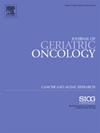Technology ownership, use, and perceptions of web-based program design features for older adults prescribed oral anticancer medication
IF 3
3区 医学
Q3 GERIATRICS & GERONTOLOGY
引用次数: 0
Abstract
Introduction
Older adults are often prescribed oral anticancer agents (OAAs). Technology-based interventions may offer medication and symptom support. We aimed to evaluate technology ownership, use, and preferred design features of a supportive web-based program using a multimethod design utilizing surveys and semi-structured interviews.
Materials and Methods
Patients were recruited from a National Cancer Institute-designated Comprehensive Cancer Center. Eligibility included those: (1) ≥65 years of age; (2) prescribed a Food and Drug Administration-approved OAA; (3) English speaking; (4) able/willing to complete telephone interviews. Interviews were audio-recorded and transcribed verbatim. Cohen's Kappa was used to evaluate inter-rater reliability and calculated at 0.87.
Results
Participants (N = 30) were predominantly female (70 %), White (83.3 %), with metastatic disease (90 %). The mean age was 74.9 years. Ninety percent owned a smartphone, 66.7 % owned a tablet, and 90 % owned a computer. Nearly 57 % reported using smartphones frequently for cancer-related purposes. Four themes with corresponding subthemes were identified: (1) comfort with technology; (2) reasons for technology use for health-related purposes (research of cancer, cancer treatment, and related symptoms/side effects; using the portal to manage health; and appointment and medication reminders); (3) recommended design features for a web-based program (OAA medication-specific information; calendars & medication alarms/reminders; symptom management & symptom trackers; and tutorials and testimonials); and (4) adaptations for older adults (simple navigation; larger font; use of layperson's terms; use of pictures, graphics, and color coding; and voice activation).
Discussion
Older adults use technology for health-related purposes. Specific web-design features and adaptations are needed to enhance usability among older adults.
老年人口服抗癌药物的技术所有权、使用和基于网络的程序设计特征的认知。
老年人经常服用口服抗癌药物(OAAs)。基于技术的干预可以提供药物和症状支持。我们的目的是评估技术的所有权,使用和首选的设计特点的支持网络程序使用多方法设计利用调查和半结构化访谈。材料和方法:患者从国家癌症研究所指定的综合癌症中心招募。入选条件包括:(1)年龄≥65岁;(二)规定的经食品药品监督管理局批准的OAA;(3)英语口语;(4)能够/愿意完成电话访谈。采访录音并逐字抄写。采用Cohen’s Kappa法评估评分者间信度,计算值为0.87。结果:参与者(N = 30)主要是女性(70%),白人(83.3%),转移性疾病(90%)。平均年龄74.9岁。90%的人拥有智能手机,66.7%的人拥有平板电脑,90%的人拥有电脑。近57%的人表示经常使用智能手机来治疗癌症。确定了四个主题及其相应的子主题:(1)技术舒适度;(2)将技术用于健康相关目的的原因(癌症研究、癌症治疗及相关症状/副作用);使用门户管理运行状况;预约和用药提醒);(3)网络项目的推荐设计特征(OAA药物特定信息);日历和药物警报/提醒;症状管理和症状追踪;教程和推荐);(4)老年人的适应性(简单导航;大的字体;使用外行术语;使用图片、图形和彩色编码;以及语音激活)。讨论:老年人出于健康目的使用技术。需要特定的网页设计功能和适应性来提高老年人的可用性。
本文章由计算机程序翻译,如有差异,请以英文原文为准。
求助全文
约1分钟内获得全文
求助全文
来源期刊

Journal of geriatric oncology
ONCOLOGY-GERIATRICS & GERONTOLOGY
CiteScore
5.30
自引率
10.00%
发文量
379
审稿时长
80 days
期刊介绍:
The Journal of Geriatric Oncology is an international, multidisciplinary journal which is focused on advancing research in the treatment and survivorship issues of older adults with cancer, as well as literature relevant to education and policy development in geriatric oncology.
The journal welcomes the submission of manuscripts in the following categories:
• Original research articles
• Review articles
• Clinical trials
• Education and training articles
• Short communications
• Perspectives
• Meeting reports
• Letters to the Editor.
 求助内容:
求助内容: 应助结果提醒方式:
应助结果提醒方式:


